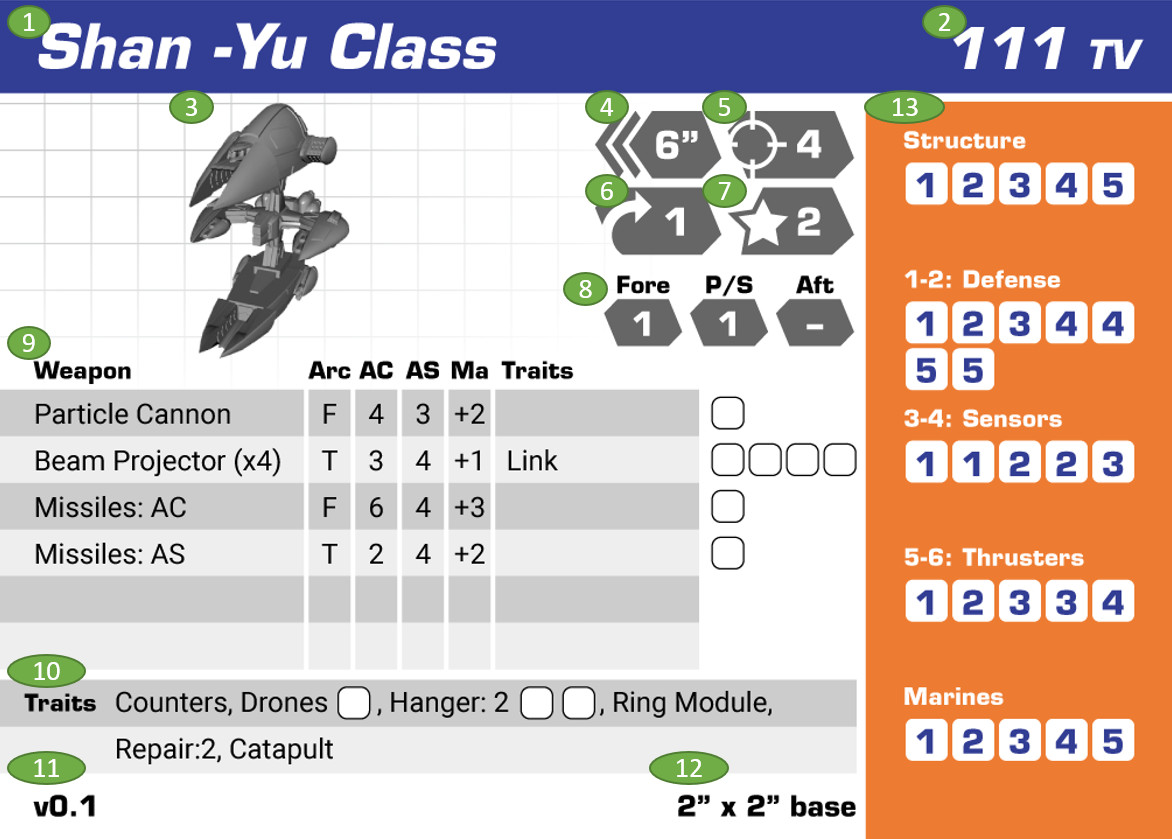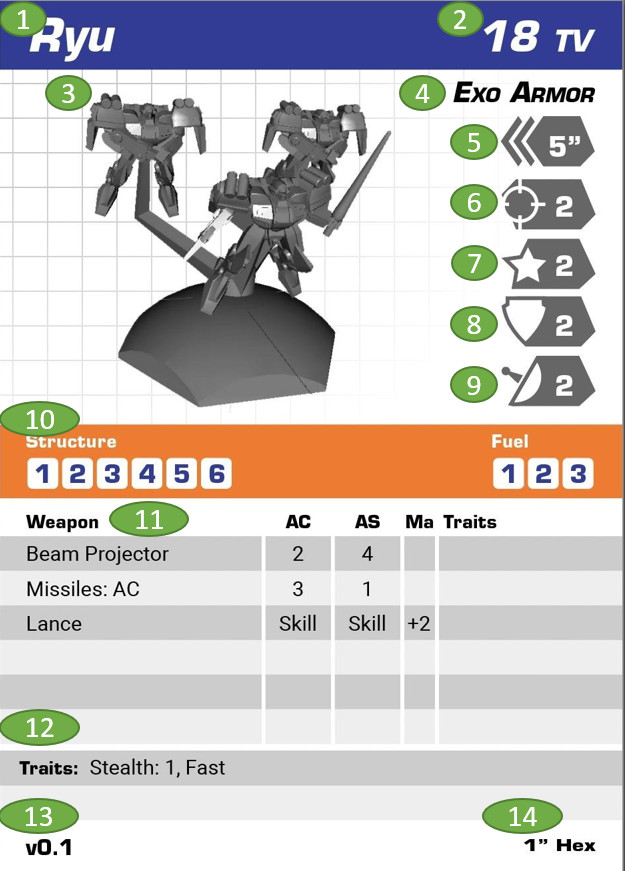Components
A Fleet consists of a number of Models. A Model may consist of a single Capital Ship figurine on its base or a squadron of Exo-Armors or Fighter figurines on their base. A Model can also be a terrain model or template such as an asteroid, comet, Habitat, or station.
In addition to models players will require:
- Some six sided dice, preferably 6 in one color and 4 in another.
- A ruler or measuring tape
- Some way of marking the Unit Cards to keep track of model state.
Model Ratings
Every model and weapon has a number of numerical values associated with it, which are termed Ratings.
Movement Ratings
Some ratings affect movement and positioning, such as:
- Speed - Represents a model's base movement speed, in inches.
- Turns (Capital Ship Only) - How many times a Capital Ship can turn in one activation.
- Thrusters (Capital Ship Only) - Represents the effectiveness of a model's maneuvering and secondary propulsion systems.
- Fuel (Squadrons Only) - An abstraction of the current reaction mass reserves available to a squadron for combat maneuvers. Note that Fuel is replenished at the end of a Squadron's activation.
Attack Ratings
Other ratings represent the firepower of a model and its ability to apply said firepower:
- Fire Control - Represents a model's ability to utilize its weapons systems. This is a result of the experience/skill of the crew and the sophistication of the model's automated targeting systems.
- Sensors - Sensors determine the effective range of a Model's weapons.
Defense Ratings
Of course, when weapons are involved, there are bound to be defensive ratings:
- Armor (Capital Ship Only) - How armored (or not) a particular arc of a ship is. Armor affects the Macro Pool of weapons targeting this ship.
- Defense - An abstraction of how effective a model's point defense systems are. This could be a representation of anti-squadron flak cannons, point defense laser batteries, etc.
- Structure - A measure of how much damage a Capital Ship can sustain before it is Crippled or a Squadron can sustain before it is Destroyed.
Crew
Finally, there are ratings to represent the crew or pilots of each Model:
- Skill - Represents the experience of the crew, pilots, or captain.
- Marines - An abstraction of how many trained soldiers are present on a ship as well as how effective they are.
Model Base Sizes
Exo-Armor and Fighter models are based on 1" Hex bases with a multi-pronged mounting supporting each model. Capital Ships are mounted on rectangular or square bases which show their attack arcs. Ships are marked on the bottom of their data cards as to which base size to use, and sold packaged with the correct base size.
Model Types
There are different model types in a game of Jovian Wars. The type of a model affects the range it can be detected by sensors and therefore the range it can be attacked from. Additionally the number of dice each weapons rolls to attack a model is determined by its type. Some Actions are restricted to certain model types.
Squadron
Exo-Armor
An Exo-Armor is a 15-30 foot tall exoskeleton with manipulators, thrusters, and an articulated frame. This flexibility gives them their chief advantages of maneuverability, a variety of weapons, and their ability to land on and attack capital ships at point blank range. Exo-Armor models are based three figures on a single 1” hex base. The term Exo-Armor can also describe large exo-suits (armored space suits).
Fighter
Fighters are light spacecraft built around extremely powerful engines that carry large quantities of ordnance, but lack some of the versatility and weapon options of Exo-Armor squadrons. Fighter models are based three figures on a single 1” hex base. The term “Fighter” can also describe fighter-bombers, reconnaissance vehicles, and bombers. Fighter squadrons may not use the Boarding Party action unless they have the Marines:X trait.
Capital Ship
Capital ships encompasses a range of craft from small freighters dozens of meters long to battleships hundreds of meters long. Capital Ships have restricted firing arcs marked on their bases in addition to a turning mark used for movement. Each weapon system is listed with a weapon arc or arcs that describe the area that the model may fire into with those weapons.
Infantry & Exo-Suits
Capital ships and installations such as orbitals and stations maintain a defensive crew of marines in armored space suits and exo-skeletons. These units are not mobile enough to operate in space away from a craft or dock but they are adept at performing boarding attacks if they can cross to a nearby enemy craft and successfully board them. Infantry and Exo-Suits are not represented by models but are the Marine rating or trait that is listed on the models that transport them. Exo-Armor models with the Exo-Suit trait are small enough to board capital ships as if they were Marines.
Terrain Model
The Jovian Wars game scenarios may include specific terrain models such as comets, asteroids, orbitals, and space stations. The model’s attributes should be determined before the game starts.
Unit Cards
Unit Cards are a way of collecting the attributes, traits, and statlines of each model. In most cases, only Capital Ships and Squadrons have Unit Cards.
Capital Ship Unit Card

- Name
- Threat Value, i.e. how many "points" a model is worth during fleet construction
- An image of the model for identification purposes.
- Speed Rating
- Fire Control Rating
- Turn Rating
- Skill Rating
- Armor Rating for each arc (Fore, Port/Starboard, Aft)
- Weapon List with Arc, Anti-Capital (AC), Anti-Squadron (AS), Macro (Ma) raitings and Traits
- Model Traits
- Rules Version of the Model
- Model base size
- Model Ratings for Structure, Defense, Sensors, Thrusters, and Marines
Squadron Unit Card

- Name
- Threat Value, i.e. how many "points" a model is worth during fleet construction
- An image of the model for identification purposes.
- Squadron Type: "Exo-Armor" or "Fighter"
- Speed Rating
- Fire Control Rating
- Skill Rating
- Defense Rating
- Sensors Rating
- Structure and Fuel Rating
- Weapon List with Anti-Capital (AC), Anti-Squadron (AS), Macro (Ma) raitings and Traits
- Model Traits
- Rules Version of the Model
- Model base size